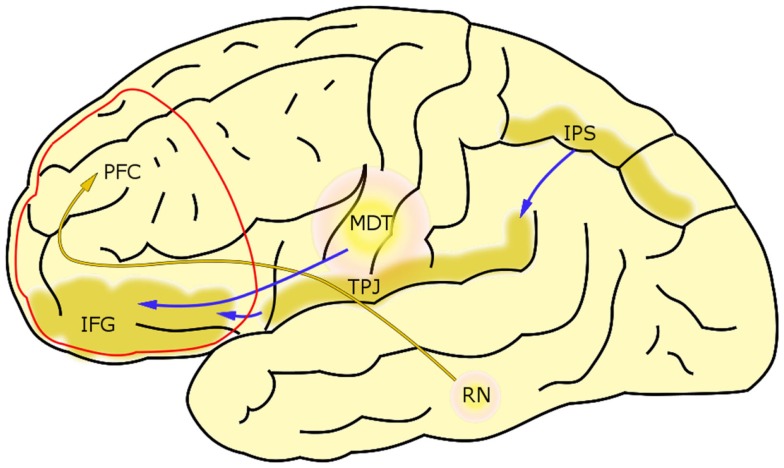Figure 5.
Attention as an example of a construct with multiple neural mechanisms underneath. Maintaining attention can be disrupted by at least two distinct mechanisms: (1) Oversensitivity of the ventral attention network. Imaging studies revealed two systems managing attention in humans. On one hand, we have dorsal attention system, consisting of frontal eye fields (FEF) and intraparietal sulcus (IPS), controlling voluntary deployment of attention (top-down control). On the other hand, we have a right-lateralized ventral attention network (VAN), responsible for orienting attention toward sensory stimuli. It involves temporoparietal junction (TPJ), intraparietal sulcus (IPS) in the parietal cortex, and inferior frontal gyrus (IFG). IFG, as a part of orbitofrontal cortex, receives a strong excitatory input from medial dorsal thalamus (MDT). Since MDT is overactive in MDD, this effect can make ventral attention network oversensitive to stimuli, and as a result holding attention on salient stimuli becomes difficult to the patient. (2) Diminished communication through coherence in the prefrontal cortex. Serotonin produced in the raphe nucleus (RN) modulates gamma oscillations in the prefrontal cortex (PFC), most probably by acting on fast-spiking interneurons expressing serotonin 5-HT2 and 5-HT6 receptors. Gamma oscillations play a key role in higher cognitive processes, including attention and working memory. Since serotonergic input to the prefrontal cortex is known to be diminished in MDD, the decrease in gamma power may account for the effect of distractibility in MDD. Both of the above mechanisms lead to a decrease in inhibition within the prefrontal cortex, which might explain why the attention, managed in the PFC, both can be disrupted in a result of hyperactivity of the medial dorsal thalamus and hypoactivity of the raphe nucleus.

